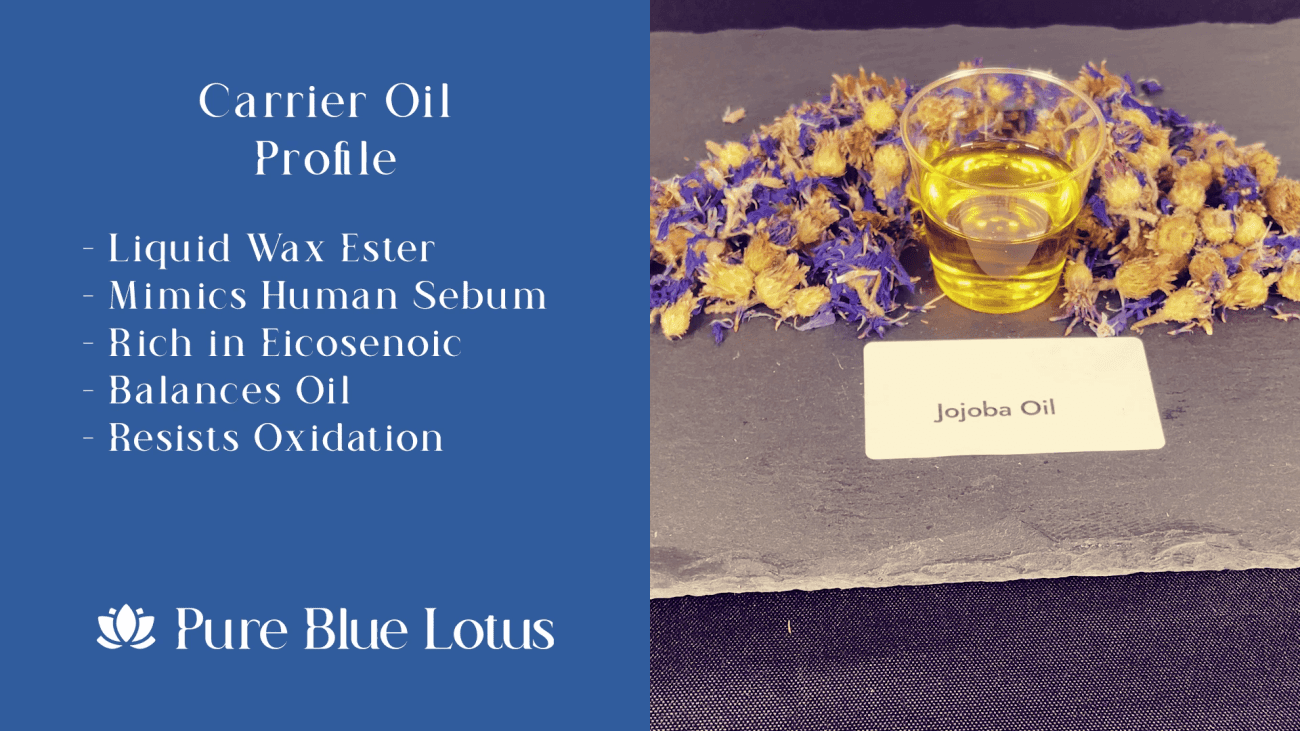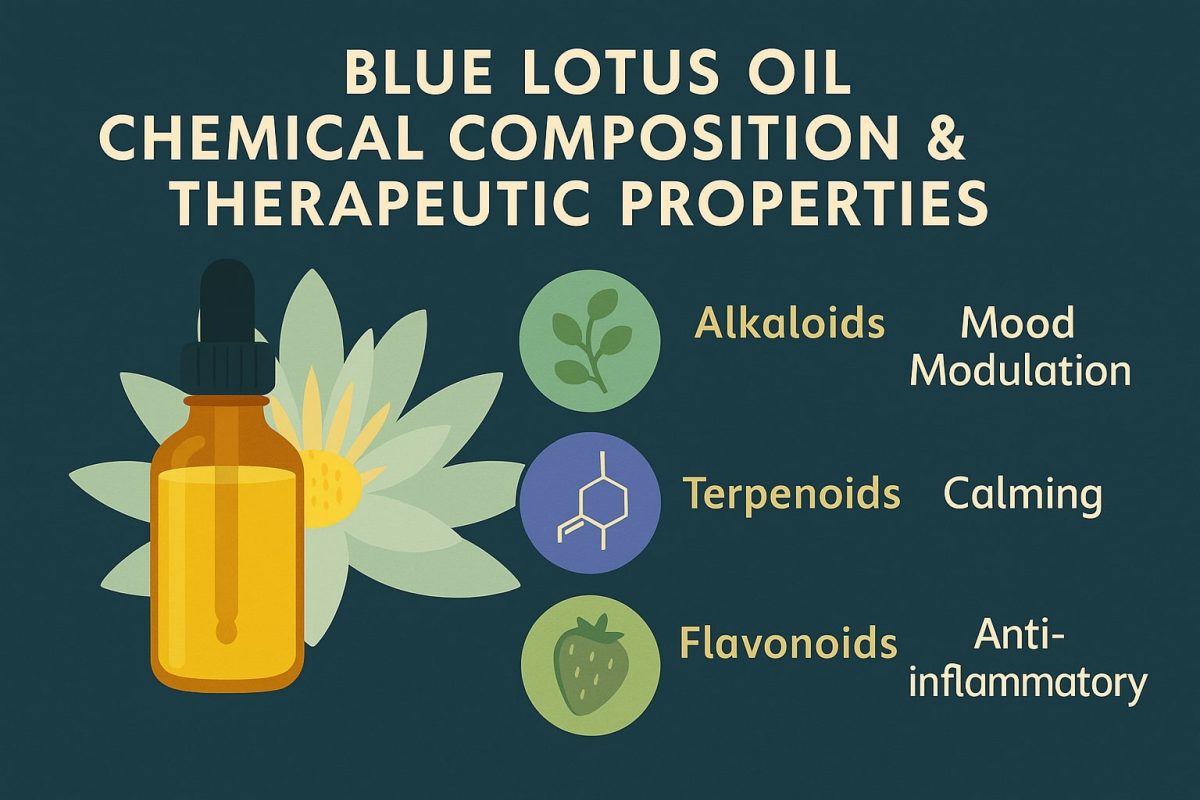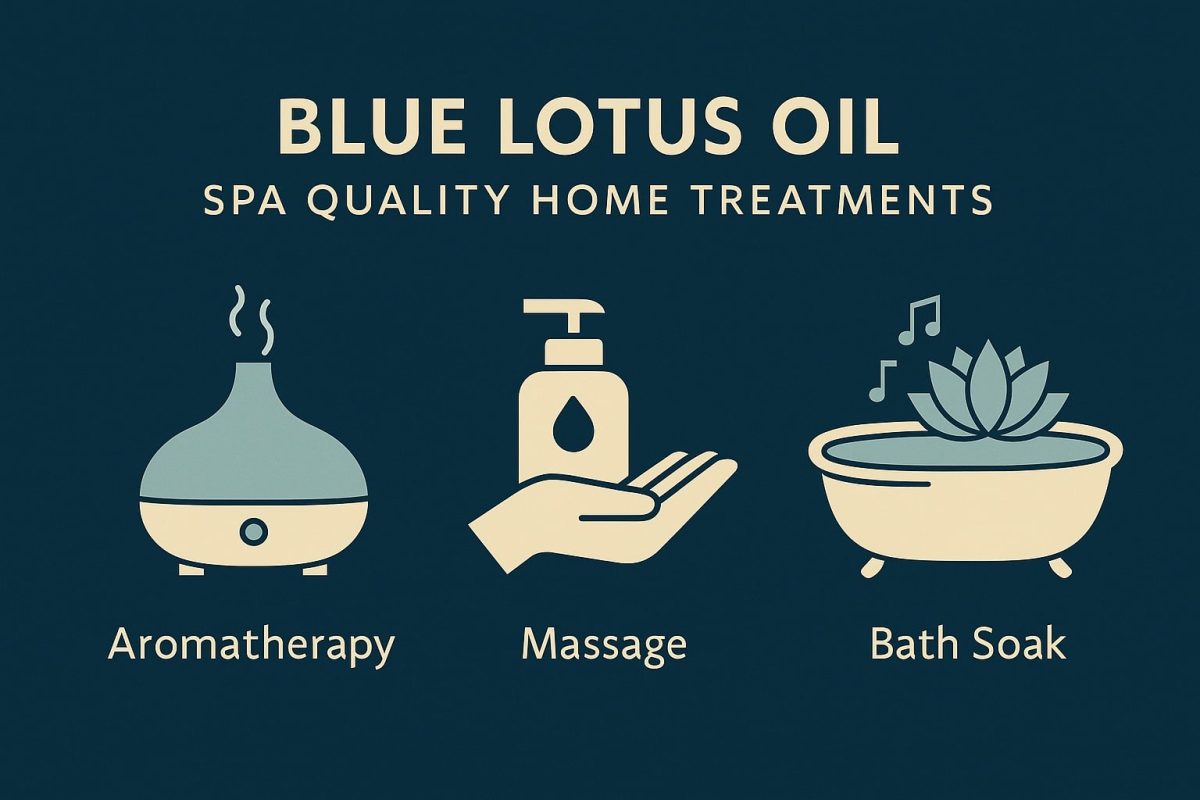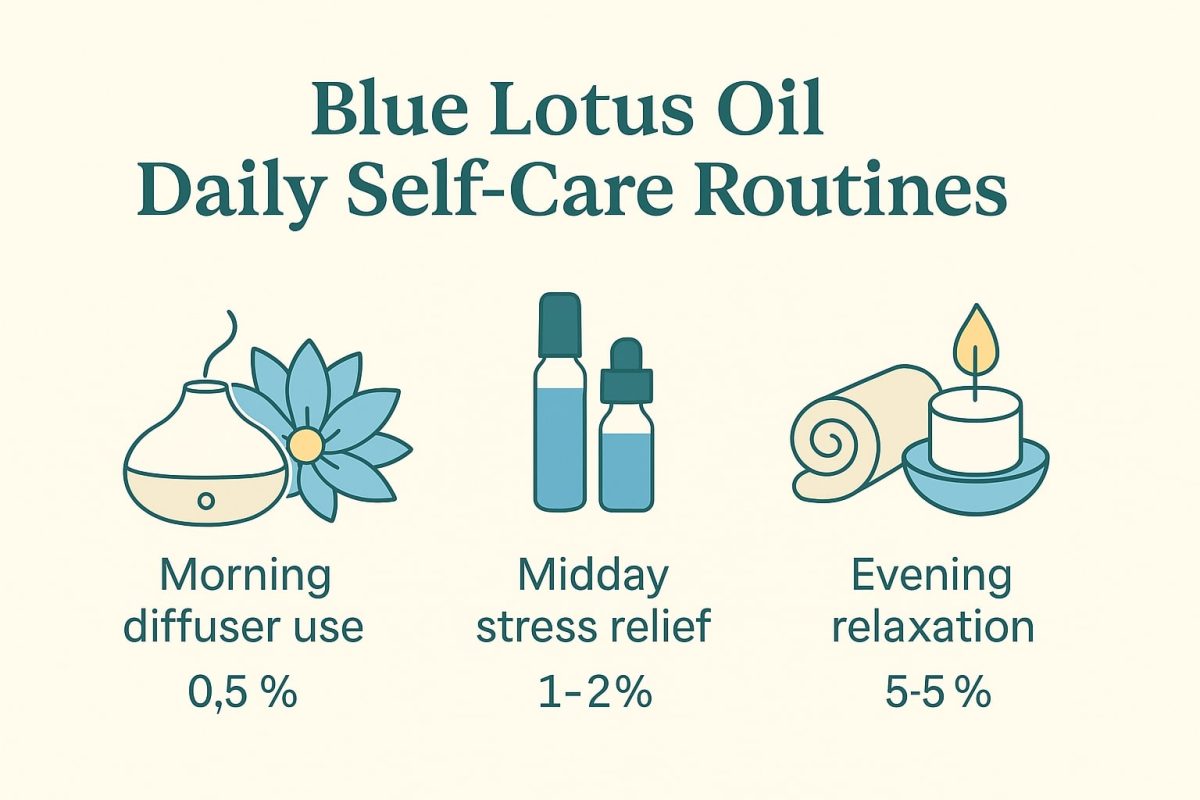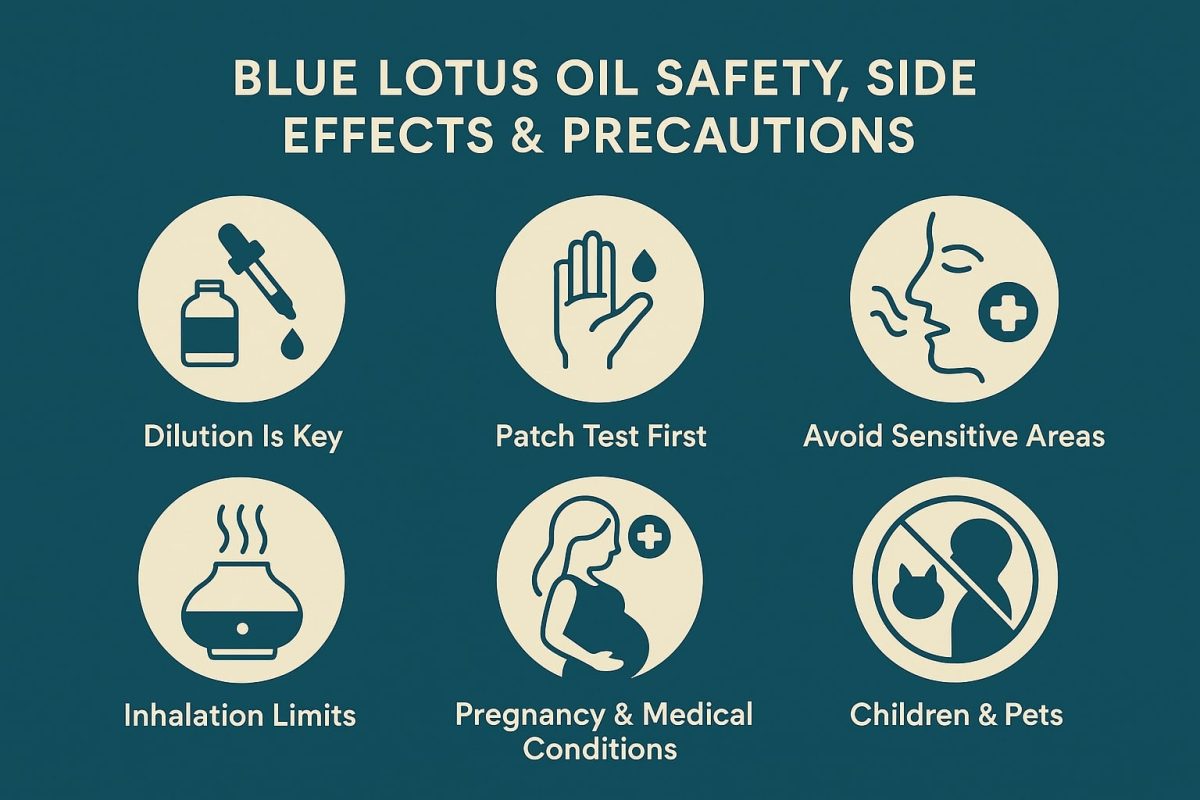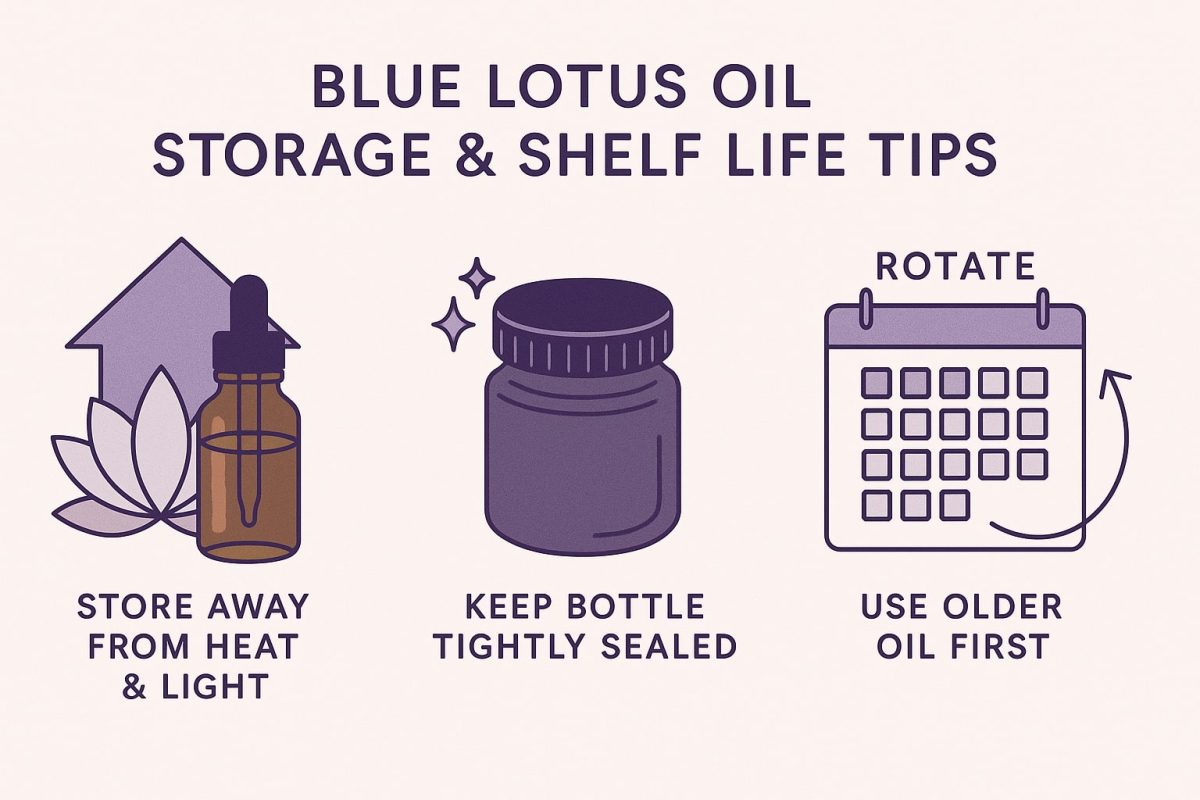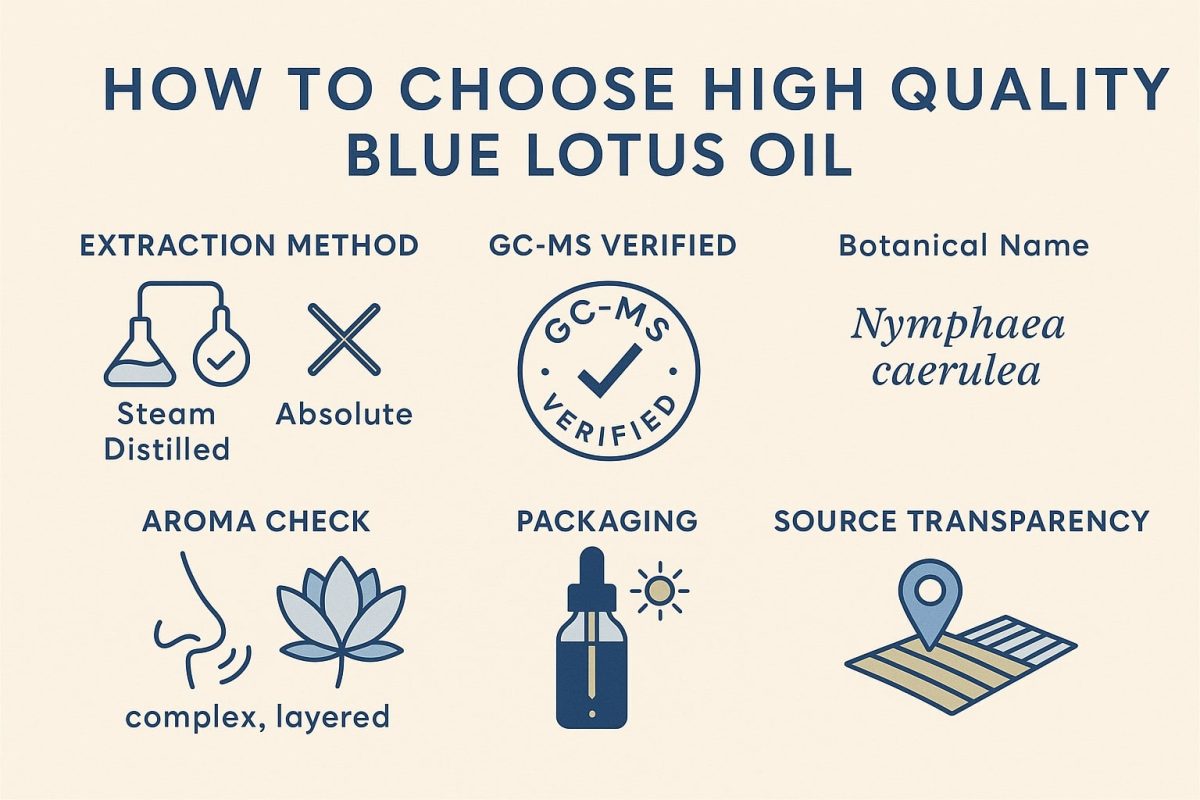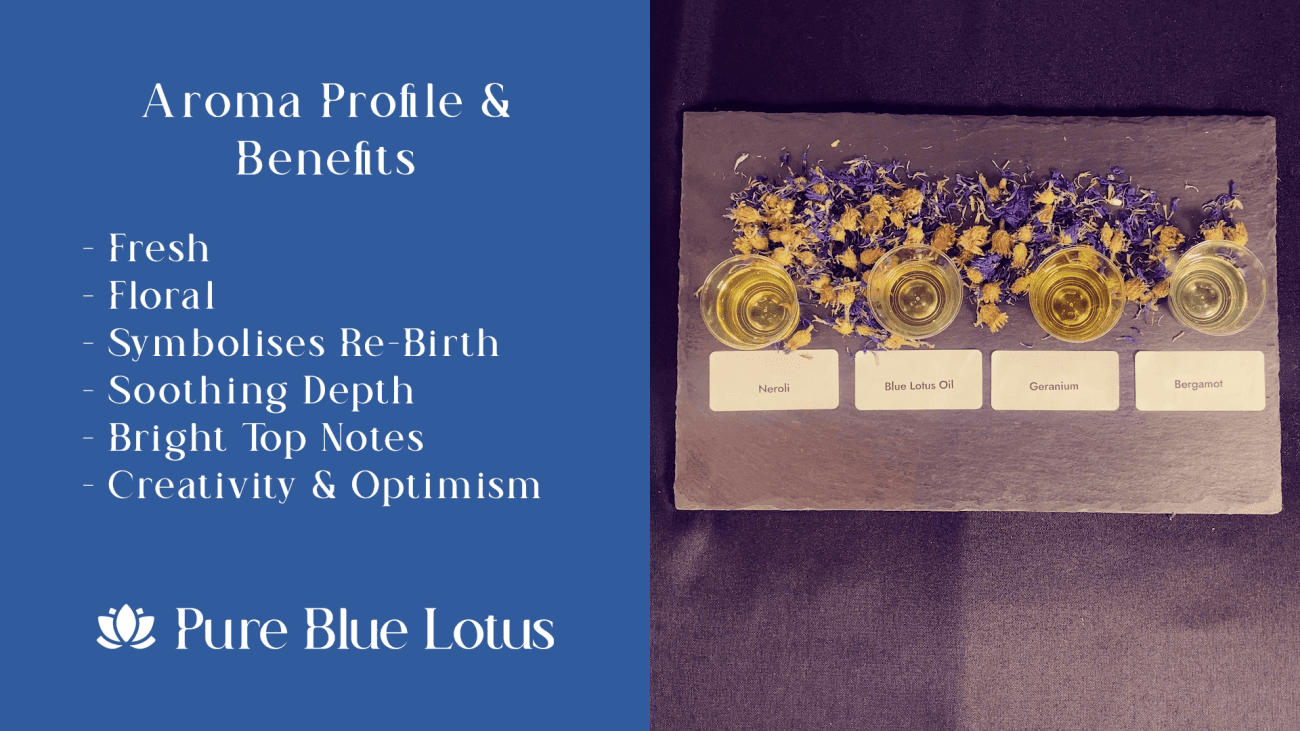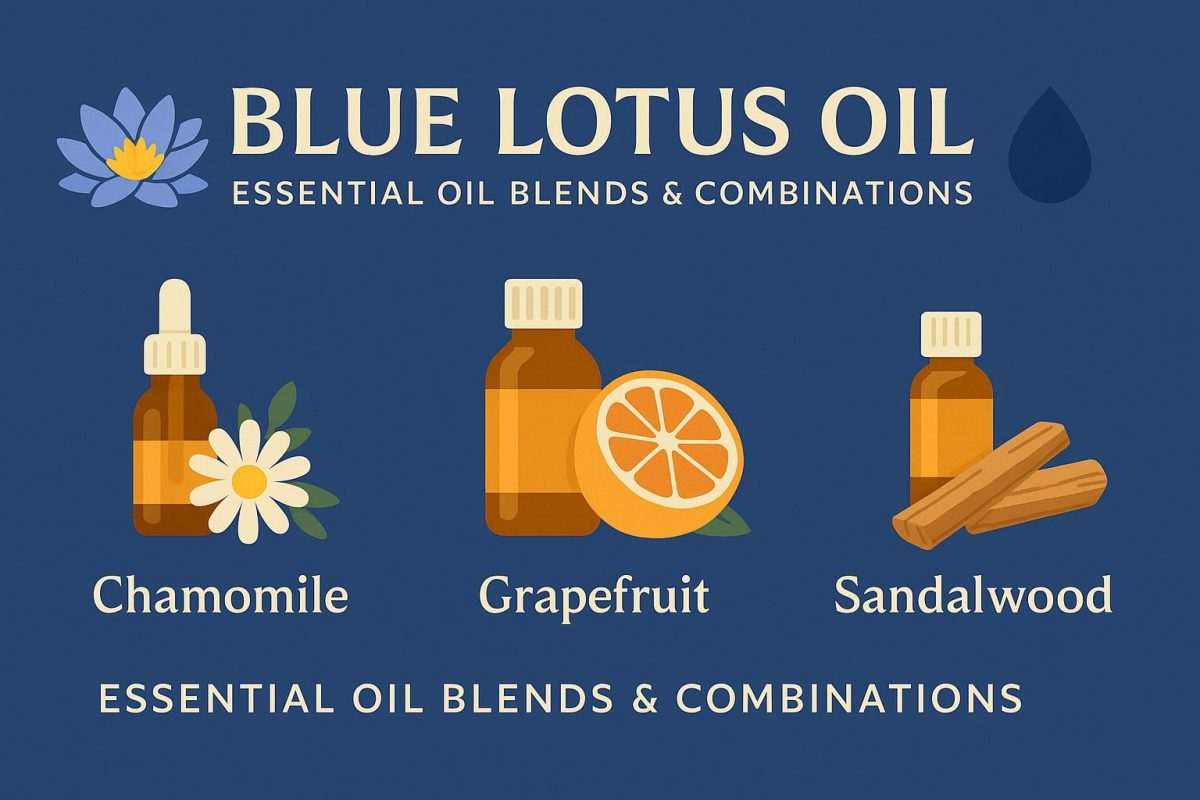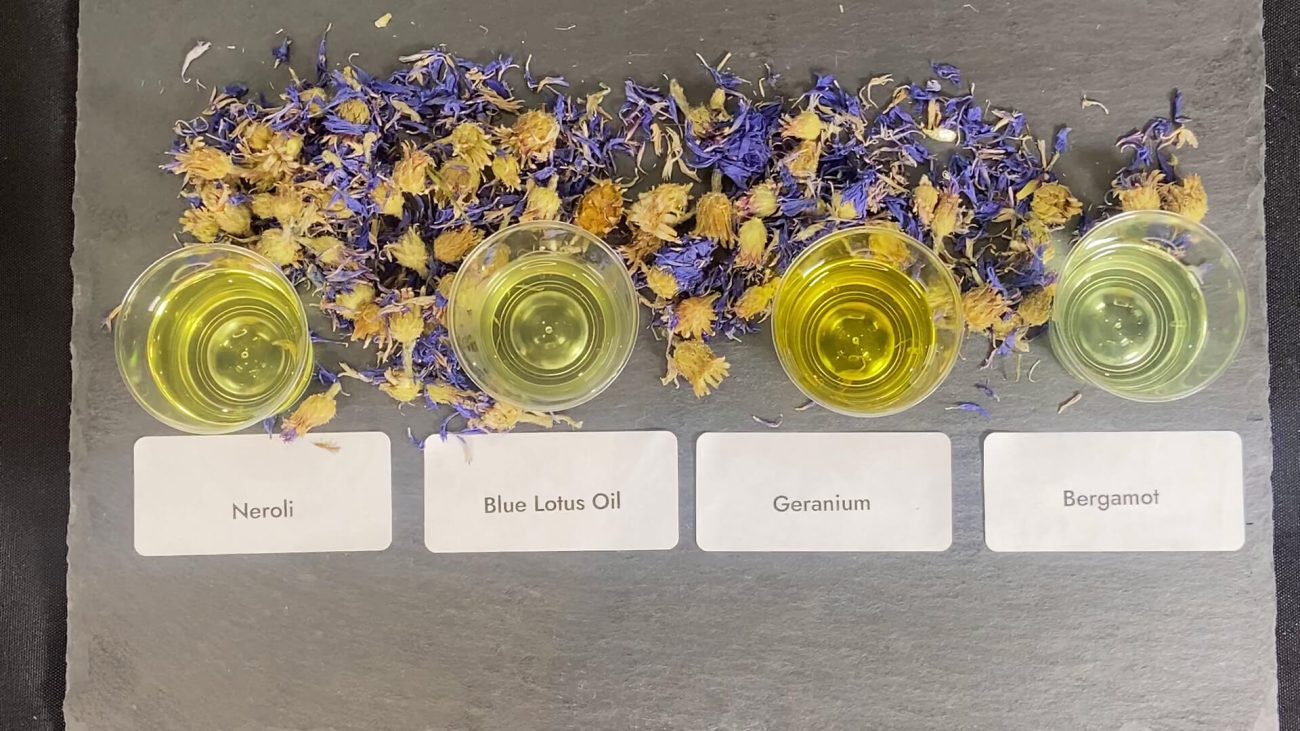Blue Lotus Essential Oil Supplier

Blue Lotus Essential Oil, derived from the petals of the sacred Nymphaea caerulea flower, is one of the rarest and most sought‑after oils in the aromatherapy and natural product markets.
For those seeking the finest, the highest quality Blue Lotus Oil, experience our hand-crafted, pure Luxury Egyptian Blue Lotus Oil (Nymphaea Caerulea) for a truly luxurious addition to your wellness routine. Find out more →
Quick Links to Useful Sections
- Botanical Origins and Historical Significance
- Extraction Methods and Chemical Composition
- Steam Distillation
- Supercritical CO2 Extraction
- Key Phytochemicals
- Evidence Based Benefits of Blue Lotus Oil
- Relaxation and Stress Relief
- Improved Sleep Quality
- Skin Nourishment and Anti Aging
- Muscle Comfort and Pain Relief
- Cognitive Focus and Creativity
- Sensual and Aphrodisiac Qualities
- Applications and Formulation Tips
- Aromatherapy Diffusers
- Topical Massage Blends
- Bath and Body Oils
- DIY Facial Serum
- Natural Perfume Formulations
- How to Choose a Reliable Supplier
- Purity and Analytical Testing
- Botanical and Geographic Transparency
- Extraction and Processing Details
- Quality Certifications
- Lot Tracking and Batch Coding
- Customer Service and Support
- Evaluating Cost and Supply Chain Factors
- Regulatory and Safety Considerations
- Case Study: Successful Supplier Partnership
- User Testimonials
- Frequently Asked Questions
In this extensive guide you will discover the oil’s remarkable history, its detailed chemical profile, evidence based benefits, best practices for selecting a reliable supplier, tips for creating your own formulations, regulatory and safety considerations, real user experiences, and answers to common questions.
Armed with this knowledge, you can confidently identify and partner with a supplier who delivers the highest quality Blue Lotus Essential Oil for your business or personal use.
Commission your made-to-order bottle of pure, undiluted Egyptian Blue Lotus Oil (Nymphaea Caerulea)
Commission your made-to-order bottle of pure, undiluted Egyptian Blue Lotus Oil (Nymphaea Caerulea)
Botanical Origins and Historical Significance
Blue Lotus, scientifically called Nymphaea caerulea, is an aquatic water lily native to the slow moving waters of the Nile River and parts of East Africa. Its broad floating leaves support striking blue to violet blossoms that open at dawn and close by midday. For over four thousand years the flower played an important role in ancient Egyptian culture. Temple reliefs and tomb paintings depict priests, pharaohs, and worshipers inhaling lotus aroma during spiritual rituals. The lotus symbolized creation, rebirth, and the cycle of the sun. Over time, Greek and Roman scholars adopted lotus preparations in perfumes, wines, and bathing rituals. Today the plant’s legacy lives on in modern aromatherapy, skincare and wellness products.
Extraction Methods and Chemical Composition
Steam Distillation
Steam distillation is the traditional method for extracting essential oil. Fresh or partially dried petals are exposed to steam, which vaporizes volatile aromatic compounds. The vapor then condenses into oil and hydrosol fractions. Steam distilled Blue Lotus Essential Oil captures top floral notes but may lose some heavier constituents.
Supercritical CO2 Extraction
Supercritical carbon dioxide extraction uses pressurized, sub‑critical CO2 as a solvent at low temperatures. This technique preserves both volatile and semi‑volatile constituents without leaving solvent residues. The resulting absolute retains the full spectrum of bioactive compounds, including alkaloids, flavonoids, and wax esters, offering a deeper, more complex aroma.
Key Phytochemicals
- Alkaloids: Nuciferine and aporphine, which may support mood modulation and mild euphoric effects when inhaled.
- Flavonoids: Quercetin and kaempferol, providing antioxidant protection and anti‑inflammatory benefits.
- Monoterpenes: Linalool and limonene, known for calming, antimicrobial, and analgesic properties.
- Sesquiterpenes: Nerolidol and farnesol, supporting skin regeneration and relaxation.
- Wax esters and fatty acids: Contribute to velvety texture and help seal in moisture when applied topically.
Evidence Based Benefits of Blue Lotus Oil
Relaxation and Stress Relief
Inhalation of Blue Lotus Essential Oil has been shown to reduce levels of cortisol, the stress hormone. Its soothing aroma encourages deep breathing and triggers the parasympathetic nervous system, helping to ease anxiety and promote a calm state of mind.
Improved Sleep Quality
Anecdotal and preliminary clinical data suggest that diffusing Blue Lotus oil before bedtime can shorten the time to fall asleep and improve overall sleep quality without causing morning grogginess.
Skin Nourishment and Anti Aging
Topical formulations containing Blue Lotus have demonstrated enhanced skin hydration, increased collagen production, and reduced transepidermal water loss. Its antioxidants help neutralize free radicals and protect against environmental damage, supporting firmer, more radiant skin.
Muscle Comfort and Pain Relief
Anti inflammatory monoterpenes and sesquiterpenes in the oil can help alleviate muscle tension and mild joint discomfort when used in massage blends or compresses.
Cognitive Focus and Creativity
Many users report heightened mental clarity and creative inspiration when diffusing Blue Lotus oil in work or studio environments. Its balanced aromatic profile uplifts the mind while maintaining a gentle, centering effect.
Sensual and Aphrodisiac Qualities
Traditionally revered as an aphrodisiac, Blue Lotus oil’s exotic floral scent can enhance romantic atmospheres and deepen emotional intimacy when incorporated into massage oils or personal fragrances.
Applications and Formulation Tips
Aromatherapy Diffusers
Add three to five drops of Blue Lotus oil to an ultrasonic diffuser with 100 to 200 ml of water. Diffuse for twenty to thirty minutes in bedrooms, living rooms, or meditation spaces to foster tranquility.
Topical Massage Blends
Combine five to ten drops of Blue Lotus oil with ten milliliters of carrier oil such as sweet almond, jojoba, or fractionated coconut. Warm the blend in your palms and massage into tense muscles or pulse points for relaxation and emotional uplift.
Bath and Body Oils
Stir ten to fifteen drops of Blue Lotus oil into a tablespoon of unscented bath salts or a quarter cup of carrier oil. Add to warm bathwater and soak for twenty minutes to soothe skin and calm the mind.
DIY Facial Serum
- Blend ten milliliters of jojoba oil with five drops of Blue Lotus oil and three drops of frankincense essential oil.
- Apply two to three drops to cleansed face and neck each evening to support hydration and skin renewal.
Natural Perfume Formulations
Start with a five percent dilution of Blue Lotus oil in perfumer’s alcohol or fractionated coconut oil. Layer with complementary notes such as rose, jasmine, sandalwood, or patchouli to create a signature scent.
How to Choose a Reliable Supplier
Selecting the right supplier ensures product integrity, ethical sourcing, and peace of mind. Key criteria include:
Purity and Analytical Testing
Request third‑party GC‑MS or HPLC reports for each batch. Certificates of Analysis verify the oil’s chemical profile, confirm the absence of adulterants, pesticides, and verify extraction method.
Botanical and Geographic Transparency
Reliable suppliers disclose the oil’s botanical name (Nymphaea caerulea), country of origin, harvest season, and cultivation methods. Ethical wildcrafting or fair trade farm sourcing supports sustainability and local communities.
Extraction and Processing Details
Suppliers should specify whether steam distillation or CO₂ extraction was used, along with any post‑processing steps. Solvent free absolutes are preferred for maximum purity.
Quality Certifications
Look for ISO, ECOCERT, USDA Organic, or Fair Trade certifications when available. These credentials provide additional assurance of ethical and environmental standards.
Lot Tracking and Batch Coding
Lot numbers and manufacturing dates allow full traceability. A transparent supplier will maintain records for recall capability and customer inquiries.
Customer Service and Support
Choose suppliers who offer technical data sheets, formulation guides, sample programs, and responsive communication. A dedicated account manager can streamline reordering and answer technical questions.
Evaluating Cost and Supply Chain Factors
- Minimum Order Quantities: Wholesale suppliers often require orders of 5 to 10 kilograms for essential oil, with tiered pricing for larger volumes.
- Pricing Tiers: Compare cost per kilogram at different volume levels. Factor in shipping, import duties, and packaging expenses.
- Lead Times: Rare oils like Blue Lotus may have seasonal harvest windows. Confirm inventory availability and estimated delivery schedules.
- Storage and Shelf Life: Ensure proper packaging (dark glass, airtight) and recommended storage conditions to maintain oil integrity for 18 to 24 months.
Regulatory and Safety Considerations
When sourcing Blue Lotus oil for cosmetics, aromatherapy, or food grade use, comply with relevant regulations:
- IFRA Standards: Adhere to International Fragrance Association guidelines for maximum safe dilution levels in skin applications.
- CPSR/CPNP Registration: Cosmetic products in Europe require Cosmetic Product Safety Reports and notification to the Cosmetic Products Notification Portal.
- REACH Compliance: Ensure the oil meets Registration, Evaluation, Authorization and Restriction of Chemicals requirements for the European market.
- Food Safety: If used in ingestible formats, verify food grade certification and compliance with local food safety authorities.
Case Study: Successful Supplier Partnership
Oasis Botanicals, a boutique skincare brand in London, partnered with a certified Egyptian distiller to secure supercritical CO₂ extracted Blue Lotus oil. Through a three‑year contract they attained volume discounts, co‑branding opportunities, and full traceability. Their Blue Lotus night serum launched to rave reviews, with a 40 percent increase in year‑over‑year sales. The partnership emphasized ethical sourcing, transparent testing, and consumer education.
User Testimonials
“Our spa switched to wholesale Blue Lotus oil from a sustainable Egyptian farm. Clients love the deep floral aroma and we save 25 percent on ingredient costs.” – Sophie, Spa Owner, Soho
“Formulating with authentic CO₂ extracted lotus absolute elevated our perfume line. The complex aroma profile is unmatched by cheaper synthetics.” – Marcus, Perfumer, East London
Frequently Asked Questions
How much does Blue Lotus Essential Oil cost wholesale?
Prices typically range from £200 to £400 per kilogram for steam distilled oil, and £400 to £800 per kilogram for CO₂ extracted absolute, depending on volume and supplier.
What is the minimum order quantity?
Most wholesale suppliers require a minimum of 5 to 10 kilograms. Some offer smaller sample packs for testing purposes.
How long does the oil remain potent?
Stored in dark glass at stable temperatures, high quality Blue Lotus oil remains potent for 18 to 24 months. Discard if the aroma or color changes noticeably.
Can I get private labeling?
Many suppliers offer private label services for orders above certain thresholds, including custom bottle labels and packaging design.
Is Blue Lotus oil safe for children?
Use caution. A dilution of 0.5 percent or less is recommended for topical applications on children. Always perform a patch test and consult a pediatrician if unsure.
For those seeking the finest, the highest quality Blue Lotus Oil, experience our hand-crafted, pure Luxury Egyptian Blue Lotus Oil (Nymphaea Caerulea) for a truly luxurious addition to your wellness routine. Find out more →

